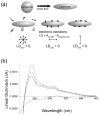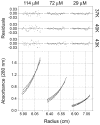In vitro dimerization of the bovine papillomavirus E5 protein transmembrane domain
- PMID: 18672907
- PMCID: PMC3711124
- DOI: 10.1021/bi8006252
In vitro dimerization of the bovine papillomavirus E5 protein transmembrane domain
Abstract
The E5 protein from bovine papillomavirus is a type II membrane protein and the product of the smallest known oncogene. E5 causes cell transformation by binding and activating the platelet-derived growth factor beta receptor (PDGFbetaR). In order to productively interact with the receptor, it is thought that E5 binds as a dimer. However, wild-type E5 and various mutants have also been shown to form trimers, tetramers, and even higher order oligomers. The residues in E5 that drive and stabilize a dimeric state are also still in question. At present, two different models for the E5 dimer exist in the literature, one symmetric and one asymmetric. There is universal agreement, however, that the transmembrane (TM) domain plays a vital role in stabilizing the functional oligomer; indeed, mutation of various TM domain residues can abolish E5 function. In order to better resolve the role of the E5 TM domain in function, we have undertaken the first quantitative in vitro characterization of the E5 TM domain in detergent micelles and liposomes. Circular and linear dichroism analyses verify that the TM domain adopts a stable alpha-helical structure and is able to partition efficiently across lipid bilayers. SDS-PAGE and analytical ultracentrifugation demonstrate for the first time that the TM domain of E5 forms a strong dimer with a standard state free energy of dissociation of 5.0 kcal mol (-1). We have used our new results to interpret existing models of E5 dimer formation and provide a direct link between TM helix interactions and E5 function.
Figures






Similar articles
-
Towards a structural understanding of the smallest known oncoprotein: investigation of the bovine papillomavirus E5 protein using solution-state NMR.Biochim Biophys Acta. 2011 Jun;1808(6):1493-501. doi: 10.1016/j.bbamem.2010.11.004. Epub 2010 Nov 10. Biochim Biophys Acta. 2011. PMID: 21073859
-
Two transmembrane dimers of the bovine papillomavirus E5 oncoprotein clamp the PDGF β receptor in an active dimeric conformation.Proc Natl Acad Sci U S A. 2017 Aug 29;114(35):E7262-E7271. doi: 10.1073/pnas.1705622114. Epub 2017 Aug 14. Proc Natl Acad Sci U S A. 2017. PMID: 28808001 Free PMC article.
-
The transmembrane domain of the E5 oncoprotein contains functionally discrete helical faces.J Biol Chem. 1999 Apr 9;274(15):10249-58. doi: 10.1074/jbc.274.15.10249. J Biol Chem. 1999. PMID: 10187811
-
The bovine papillomavirus E5 protein and the PDGF beta receptor: it takes two to tango.Virology. 2009 Feb 20;384(2):345-51. doi: 10.1016/j.virol.2008.09.033. Epub 2008 Nov 6. Virology. 2009. PMID: 18990418 Free PMC article. Review.
-
The platelet-derived growth factor beta receptor as a target of the bovine papillomavirus E5 protein.Cytokine Growth Factor Rev. 2000 Dec;11(4):283-93. doi: 10.1016/s1359-6101(00)00012-5. Cytokine Growth Factor Rev. 2000. PMID: 10959076 Review.
Cited by
-
The E5 proteins.Virology. 2013 Oct;445(1-2):99-114. doi: 10.1016/j.virol.2013.05.006. Epub 2013 May 31. Virology. 2013. PMID: 23731971 Free PMC article. Review.
-
Papillomavirus E5: the smallest oncoprotein with many functions.Mol Cancer. 2011 Nov 11;10:140. doi: 10.1186/1476-4598-10-140. Mol Cancer. 2011. PMID: 22078316 Free PMC article. Review.
-
Hydrophobic Mismatch Drives the Interaction of E5 with the Transmembrane Segment of PDGF Receptor.Biophys J. 2015 Aug 18;109(4):737-49. doi: 10.1016/j.bpj.2015.07.022. Biophys J. 2015. PMID: 26287626 Free PMC article.
-
Construction and genetic selection of small transmembrane proteins that activate the human erythropoietin receptor.Proc Natl Acad Sci U S A. 2010 Feb 23;107(8):3447-52. doi: 10.1073/pnas.0915057107. Epub 2010 Feb 8. Proc Natl Acad Sci U S A. 2010. PMID: 20142506 Free PMC article.
-
Artificial transmembrane oncoproteins smaller than the bovine papillomavirus E5 protein redefine sequence requirements for activation of the platelet-derived growth factor beta receptor.J Virol. 2009 Oct;83(19):9773-85. doi: 10.1128/JVI.00946-09. Epub 2009 Jul 15. J Virol. 2009. PMID: 19605488 Free PMC article.
References
-
- Drummond-Barbosa D, DiMaio D. Virocrine transformation. Biochem Biophys Acta. 1997;1332:M1–M17. - PubMed
-
- DiMaio D, Lai CC, Klein O. Virocrine transformation: the intersection between viral transforming proteins and cellular signal transduction pathways. Annual review of microbiology. 1998;52:397–421. - PubMed
-
- DiMaio D, Lai CC, Mattoon D. The platelet-derived growth factor beta receptor as a target of the bovine papillomavirus E5 protein. Cytokine Growth Factor Rev. 2000;11:283–293. - PubMed
Publication types
MeSH terms
Substances
Grants and funding
LinkOut - more resources
Full Text Sources

